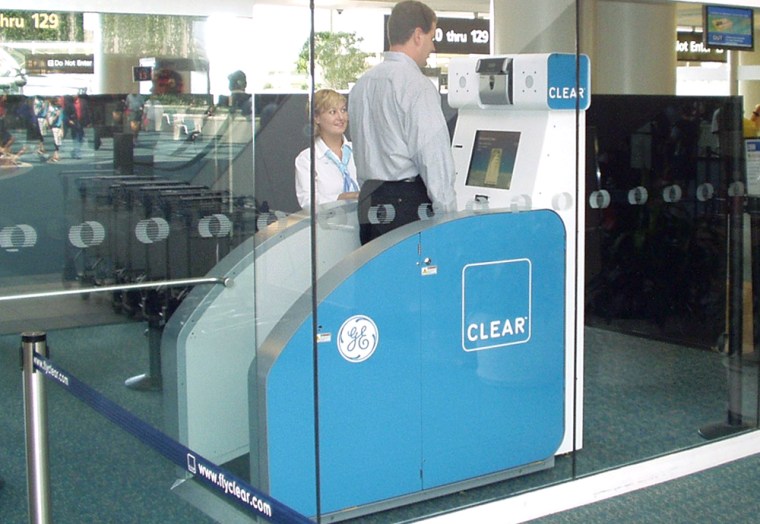While thousands of travelers queued up daily at Orlando International Airport, yanking off their shoes and shoving them through X-ray machines, a select few got to avoid the hassle during the latter part of 2006 — and passengers at four other airports nationally will soon join them.
These travelers, who paid a $100 fee and underwent a background check to be part of a test program, bypassed the line and stepped into what may be a glimpse of the future — they inserted a biometric identification card into a kiosk that scanned their irises and their fingerprints to verify their identity, placed a fingertip on an explosives scanning device and stood on a scanning platform that determined whether their footwear hid a bomb.
Operated by Verified Identity Pass Inc., a New York City-based company headed by Court TV founder Steven Brill, the GE Security screening kiosks will go into official use this month in Orlando and are expected to also begin operation at the Cincinnati, Indianapolis, San Jose, Calif., airports, and Terminal 7 at New York’s JFK International Airport. Only the shoe scanner has received Transportation Security Administration approval for official use to date, so customers won’t get the fingertip scan, at least initially.
“Wouldn’t it have been nice if they had that system in Denver right now?” said painting contractor John Fox as he traveled from Florida to his snow-walloped, jam-packed home airport recently. Even though he only flies about three times a year, he said he would sign up if Denver’s airport got the program. “It’s giving up a little privacy for efficiency. I’m all for it.”
While some might see the new system as first-class treatment for a paying few, analysts said this model will drive future advances in screening technology as those willing to pay for convenience spur development of machines that will eventually be used by all. It’s a trend toward greater privatization of security technology development with the government taking the role of regulator.
“The kiosks are going to fundamentally change aviation security,” said Matthew Farr, senior homeland security analyst for consulting firm Frost & Sullivan. “Up to now, you’ve been relying on the government. The government has been extremely slow to adapt to the next generation of security technology.”
But experts can’t predict when GE Security’s latest technology will become commonplace because there are several obstacles standing in the way of widespread deployment. And there have been setbacks in similar programs — for example, further rollout of GE Security’s “puffer” machine, which inspects passengers for explosives residue at 37 airports, was recently suspended because of reliability concerns.
“It’s going to be a long time because the technology is expensive and it’s immature,” said Tom LaTourrette, a physical scientist with the RAND Corp. “The shoes aren’t that big a part of (the screening process).”
Unisys Corp. and EDS Corp., competitors of Verified Identity Pass, have participated in pilot projects at several other airports. All three companies are vying for business after the TSA transferred to the private sector the administration of its Registered Traveler program. Registered Traveler was authorized by Congress five years ago to give frequent travelers a more predictable, quicker screening experience.
Verified hopes to expand the Orlando program to 20 airports by the end of the year. With the TSA’s recent approval of the shoe scanner developed in a cross-licensing agreement between GE Security — a subsidiary of General Electric Co. — and Australia-based QRSciences, Verified hopes many additional travelers will sign up at the $100 yearly fee.
Verified’s customers still have to walk through a metal detector and place their bags in the X-ray machine, but the company says its 30,000 Orlando customers — and another 5,000 who have signed up in advance for the programs at the four other airports — are a testament to its quicker screening process.
Simon Bedford, QRSciences vice president of business development, said the shoe scanner applies old technology — quadrupole resonance —that was used in the Vietnam War to detect land mines.
The shoe scanner uses AM radio waves to resonate the molecules inside shoes, creating a frequency that is unique to particular types of molecules. The device then compares the frequency to those of a range of substances, deciding if the traveler is just wearing shoes or something that could be an explosive. Al-Qaida operative Richard Reid tried to blow up a Paris to Miami flight using a shoe bomb in 2001, but he couldn’t get it lit before a flight attendant and passengers subdued him.
Citing security reasons, GE Security and QRSciences won’t talk specifically about how the technology stacks up against the standard procedure of removing shoes and placing them on the X-ray machine. They point to TSA approval as validation.
“We’re confident that the shoe scanner can screen shoes,” said TSA spokesman Christopher White, declining to elaborate further.
But it may be awhile before most travelers step onto the new shoe scanner.
First, GE Security’s kiosks cost $200,000 each, making them too expensive for the government to buy for widespread use. Farr, the analyst, said the kiosk itself may never be adopted for use on the general public, but its components will likely be deployed piecemeal.
Another obstacle, Farr said, is the current requirement of a background check and biometric card. For the mass traveling public to accept the process, the machines will need to be able to read driver’s licenses, which differ from state to state. For the system to work, a traveler’s card needs to work at every machine at every airport.
Another consideration: The widespread use of technology may threaten the jobs of many TSA screeners — a difficult pill to swallow for a government bureaucracy trying to compete for funding, Farr said.
